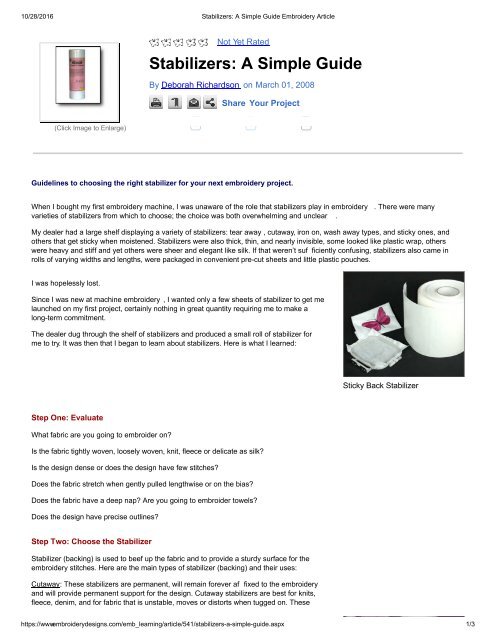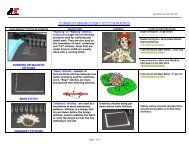Compiled Embroidery Skill Articles
Create successful ePaper yourself
Turn your PDF publications into a flip-book with our unique Google optimized e-Paper software.
10/28/2016 Stabilizers: A Simple Guide <strong>Embroidery</strong> Article<br />
Not Yet Rated<br />
Stabilizers: A Simple Guide<br />
By Deborah Richardson on March 01, 2008<br />
Share Your Project<br />
(Click Image to Enlarge)<br />
0 0 0<br />
Guidelines to choosing the right stabilizer for your next embroidery project.<br />
When I bought my first embroidery machine, I was unaware of the role that stabilizers play in embroidery<br />
varieties of stabilizers from which to choose; the choice was both overwhelming and unclear .<br />
. There were many<br />
My dealer had a large shelf displaying a variety of stabilizers: tear away , cutaway, iron on, wash away types, and sticky ones, and<br />
others that get sticky when moistened. Stabilizers were also thick, thin, and nearly invisible, some looked like plastic wrap, others<br />
were heavy and stiff and yet others were sheer and elegant like silk. If that weren’t suf ficiently confusing, stabilizers also came in<br />
rolls of varying widths and lengths, were packaged in convenient precut sheets and little plastic pouches.<br />
I was hopelessly lost.<br />
Since I was new at machine embroidery , I wanted only a few sheets of stabilizer to get me<br />
launched on my first project, certainly nothing in great quantity requiring me to make a<br />
longterm commitment.<br />
The dealer dug through the shelf of stabilizers and produced a small roll of stabilizer for<br />
me to try. It was then that I began to learn about stabilizers. Here is what I learned:<br />
Sticky Back Stabilizer<br />
Step One: Evaluate<br />
What fabric are you going to embroider on?<br />
Is the fabric tightly woven, loosely woven, knit, fleece or delicate as silk?<br />
Is the design dense or does the design have few stitches?<br />
Does the fabric stretch when gently pulled lengthwise or on the bias?<br />
Does the fabric have a deep nap? Are you going to embroider towels?<br />
Does the design have precise outlines?<br />
Step Two: Choose the Stabilizer<br />
Stabilizer (backing) is used to beef up the fabric and to provide a sturdy surface for the<br />
embroidery stitches. Here are the main types of stabilizer (backing) and their uses:<br />
Cutaway: These stabilizers are permanent, will remain forever af fixed to the embroidery<br />
and will provide permanent support for the design. Cutaway stabilizers are best for knits,<br />
fleece, denim, and for fabric that is unstable, moves or distorts when tugged on. These<br />
stabilizers come in weights from heavy to light and should be matched to the weight of the<br />
https://www.embroiderydesigns.com/emb_learning/article/541/stabilizersasimpleguide.aspx 1/3




